DeWalt D25211K Handleiding
Bekijk gratis de handleiding van DeWalt D25211K (7 pagina’s), behorend tot de categorie Hamer. Deze gids werd als nuttig beoordeeld door 37 mensen en kreeg gemiddeld 3.6 sterren uit 19 reviews. Heb je een vraag over DeWalt D25211K of wil je andere gebruikers van dit product iets vragen? Stel een vraag
Pagina 1/7

INSTRUCTION MANUAL
GUIDE D'UTILISATION
MANUAL DE INSTRUCCIONES
INSTRUCTIVO DE OPERACIÓN, CENTROS DE SERVICIO Y PÓLIZA
DE GARANTÍA. ADVERTENCIA: LÉASE ESTE INSTRUCTIVO ANTES
DE USAR EL PRODUCTO.
DEWALT Industrial Tool Co., 701 Joppa Road, Baltimore, MD 21286
(OCT06) Form No. 495266-02 D25111, etc. Copyright © 2006 DEWALT
The following are trademarks for one or more DEWALT power tools: the yellow and black color
scheme; the “D” shaped air intake grill; the array of pyramids on the handgrip; the kit box
configuration; and the array of lozenge-shaped humps on the surface of the tool.
D25111, D25113, D25211, D25213, D25313, D25314 1" (26 mm) Heavy-Duty SDS Rotary Hammers
D25330 Heavy-Duty SDS Chipping Hammer
Modèles D25111, D25113, D25211, D25213, D25313 et D25314 Perceuse à percussion SDS de 26 mm (1 po) de service intensif
Marteau burineur robuste SDS, modèle D25330
Martillos giratorios SDS de 26 mm (1") para trabajo pesado D25111, D25113, D25211, D25213, D25313, D25314
Martillo cincelador SDS para trabajo pesado D25330
If you have questions or comments, contact us.
Pour toute question ou tout commentaire, nous contacter.
Si tiene dudas o comentarios, contáctenos.
1-800-4-DEWALT • www.dewalt.com
Definitions: Safety Guidelines
The definitions below describe the level of severity for each signal word. Please read the
manual and pay attention to these symbols.
DANGER: Indicates an imminently hazardous situation which, if not avoided, will result
in death or serious injury.
WARNING: could Indicates a potentially hazardous situation which, if not avoided,
result in death or serious injury.
CAUTION: may Indicates a potentially hazardous situation which, if not avoided, result
in minor or moderate injury.
CAUTION: Used without the safety alert symbol indicates a potentially hazardous situation
which, if not avoided, may result in property damage.
IF YOU HAVE ANY QUESTIONS OR COMMENTS ABOUT THIS OR ANY DEWALT TOOL,
CALL US TOLL FREE AT: 1-800-4-DEWALT (1-800-433-9258)
General Safety Rules
WARNING! To reduce risk of injury, user must read instruction manual.
Failure to follow all instructions listed below may result in electric shock, fire
and/or serious injury. The term “power tool” in all of the warnings listed below
refers to your mains-operated (corded) power tool or battery-operated (cordless)
power tool.
SAVE THESE INSTRUCTIONS
1) WORK AREA SAFETY
a) Keep work area clean and well lit. Cluttered or dark areas invite accidents.
b) Do not operate power tools in explosive atmospheres, such as in the presence of
flammable liquids, gases or dust. Power tools create sparks which may ignite the dust
or fumes.
c) Keep children and bystanders away while operating a power tool. Distractions can
cause you to lose control.
2) ELECTRICAL SAFETY
a) Power tool plugs must match the outlet. Never modify the plug in any way. Do not
use any adapter plugs with earthed (grounded) power tools. Unmodified plugs and
matching outlets will reduce risk of electric shock.
b) Avoid body contact with earthed or grounded surfaces such as pipes, radiators,
ranges and refrigerators. There is an increased risk of electric shock if your body is
earthed or grounded.
c) Do not expose power tools to rain or wet conditions. Water entering a power tool will
increase the risk of electric shock
d) Do not abuse the cord. Never use the cord for carrying, pulling or unplugging the
power tool. Keep cord away from heat, oil, sharp edges or moving parts. Damaged
or entangled cords increase the risk of electric shock. Have damaged cords repaired
or replaced by an authorized service center. Use only 3-wire extension cords that have
3-prong grounding-type plugs and 3-pole receptacles that accept the tool’s plug.
e) When operating a power tool outdoors, use an extension cord suitable for outdoor
use. Use of a cord suitable for outdoor use reduces the risk of electric shock. Make sure
your extension cord is in good condition. When using an extension cord, be sure to use
one heavy enough to carry the current your product will draw. An undersized cord will
cause a drop in line voltage resulting in loss of power and overheating. The following table
shows the correct size to use depending on cord length and nameplate ampere rating. If in
doubt, use the next heavier gauge. The smaller the gauge number, the heavier the cord.
Minimum Gauge for Cord Sets
Ampere Rating
Volts Total Length of Cord in Feet
120V 25 50 100 150
240V 50 100 200 300
More
Than
Not More
Than
AWG
0 6 18 16 16 14
6 10 18 16 14 12
10 12 16 16 14 12
12 16 14 12 Not Recommended
3) PERSONAL SAFETY
a) Stay alert, watch what you are doing and use common sense when operating a
power tool. Do not use a power tool while you are tired or under the influence of
drugs, alcohol or medication. A moment of inattention while operating power tools may
result in serious personal injury.
b) Use safety equipment. Always wear eye protection. Safety equipment such as
dust mask, non-skid safety shoes, hard hat, or hearing protection used for appropriate
conditions will reduce personal injuries.
c) Avoid accidental starting. Ensure the switch is in the off-position before plugging
in. Carrying power tools with your finger on the switch or plugging in power tools that have
the switch on invites accidents.
d) Remove any adjusting key or wrench before turning the power tool on. A wrench or
a key left attached to a rotating part of the power tool may result in personal injury.
e) Do not overreach. Keep proper footing and balance at all times. This enables better
control of the power tool in unexpected situations.
f) Dress properly. Do not wear loose clothing or jewellery. Keep your hair, clothing and
gloves away from moving parts. Loose clothes, jewellery or long hair can be caught in
moving parts. Air vents often cover moving parts and should also be avoided.
g) If devices are provided for the connection of dust extraction and collection facilities,
ensure these are connected and properly used. Use of these devices can reduce dust-
related hazards.
4) POWER TOOL USE AND CARE
a) Do not force the power tool. Use the correct power tool for your application. The
correct power tool will do the job better and safer at the rate for which it was designed.
b) Do not use the power tool if the switch does not turn it on and off. Any power tool
that cannot be controlled with the switch is dangerous and must be repaired.
c) Disconnect the plug from the power source and/or the battery pack from the power
tool before making any adjustments, changing accessories, or storing power tools.
Such preventive safety measures reduce the risk of starting the power tool accidentally.
d) Store idle power tools out of the reach of children and do not allow persons
unfamiliar with the power tool or these instructions to operate the power tool. Power
tools are dangerous in the hands of untrained users.
e) Maintain power tools. Check for misalignment or binding of moving parts, breakage
of parts and any other condition that may affect the power tools operation. If
damaged, have the power tool repaired before use. Many accidents are caused by
poorly maintained power tools.
f) Keep cutting tools sharp and clean. Properly maintained cutting tools with sharp cutting
edges are less likely to bind and are easier to control.
g) Use the power tool, accessories and tool bits etc., in accordance with these
instructions and in the manner intended for the particular type of power tool, taking
into account the working conditions and the work to be performed. Use of the power
tool for operations different from those intended could result in a hazardous situation.
5) SERVICE
a) Have your power tool serviced by a qualified repair person using only identical
replacement parts. This will ensure that the safety of the power tool is maintained.
Additional Safety Instructions for Rotary Hammers
• Hold power tools by insulated gripping surfaces when performing an operation
where the cutting tool may contact hidden wiring or its own cord. Contact with a “live”
wire will make exposed metal parts of the tool “live” and shock the operator.
Be certain that the material being drilled does not conceal electric or gas service and that
their locations have been verified with the utility companies.
• Wear ear protectors. Exposure to noise can cause hearing loss.
• Use auxiliary handles supplied with the tool.
Loss of control can cause personal injury.Keep a firm grip on the tool at all times. Do not
attempt to operate this tool without holding it with both hands. Operating this tool with one
hand will result in loss of control. Breaking through or encountering hard materials such as
re-bar may be hazardous as well. Tighten the side handle securely before use.
• Use clamps or other practical way to secure and support the workpiece to a stable
platform. Holding the work by hand or against your body is unstable and may lead to loss of
control.
• Wear safety goggles or other eye protection. Hammering operations cause chips to
fly. Flying particles can cause permanent eye damage. Wear a dust mask or respirator for
applications that generate dust. Ear protection may be required for most applications.
• Keep a firm grip on the tool at all times. Do not attempt to operate this tool without
holding it with both hands. It is recommended that the side handle be used at all
times. Operating this tool with one hand will result in loss of control. Breaking through or
encountering hard materials such as re-bar may be hazardous as well.
• Do not operate this tool for long periods of time. Vibration caused by hammer action may
be harmful to your hands and arms. Use gloves to provide extra cushion and limit exposure
by taking frequent rest periods.
• Do not recondition bits yourself. Chisel reconditioning should be done by an authorized
specialist. Improperly reconditioned chisels could cause injury.
• Wear gloves when operating tool or changing bits. Accessible metal parts on the tool
and bits may get extremely hot during operation. Small bits of broken material may damage
bare hands.
• Never lay the tool down until the bit has come to a complete stop. Moving bits could
cause injury.
• Do not strike jammed bits with a hammer to dislodge them. Fragments of metal or
material chips could dislodge and cause injury.
• Slightly worn chisels can be resharpened by grinding.
• Keep the power cord away from the rotating bit. Do not wrap the cord around any part
of your body. An electric cord wrapped around a spinning bit may cause personal injury and
loss of control.
NOTE: Do not overheat the bit (discoloration) while grinding a new edge. Badly worn chisels
require reforging. Do not reharden and temper the chisel.
WARNING: ALWAYS use safety glasses. Everyday eyeglasses are NOT safety glasses. Also
use face or dust mask if cutting operation is dusty. ALWAYS WEAR CERTIFIED SAFETY
EQUIPMENT:
• ANSI Z87.1 eye protection (CAN/CSA Z94.3),
• ANSI S12.6 (S3.19) hearing protection,
• NIOSH/OSHA/MSHA respiratory protection.
WARNING: Some dust created by power sanding, sawing, grinding, drilling, and other
construction activities contains chemicals known to cause cancer, birth defects or other
reproductive harm. Some examples of these chemicals are:
• lead from lead-based paints,
• crystalline silica from bricks and cement and other masonry products, and
• arsenic and chromium from chemically-treated lumber.
Your risk from these exposures varies, depending on how often you do this type of work. To
reduce your exposure to these chemicals: work in a well ventilated area, and work with approved
safety equipment, such as those dust masks that are specially designed to filter out microscopic
particles.
• Avoid prolonged contact with dust from power sanding, sawing, grinding, drilling,
and other construction activities. Wear protective clothing and wash exposed areas
with soap and water. Allowing dust to get into your mouth, eyes, or lay on the skin may
promote absorption of harmful chemicals.
WARNING: Use of this tool can generate and/or disburse dust, which may cause serious and
permanent respiratory or other injury. Always use NIOSH/OSHA approved respiratory protection
appropriate for the dust exposure. Direct particles away from face and body.
WARNING: Always use eye protection. All users and bystanders must wear eye protection
that conforms to ANSI Z87.1.
WARNING: Always wear proper personal hearing protection that conforms to ANSI
S12.6 (S3.19) during use. Under some conditions and duration of use, noise from this product
may contribute to hearing loss.
• The label on your tool may include the following symbols. The symbols and their definitions
are as follows:
V ..................volts A .................... amperes
Hz ................hertz W ................... watts
min ..............minutes .................. alternating current
............direct current no ................... no load speed
................Class I Construction ................... earthing terminal
.................... (grounded) ................... safety alert symbol
................. Class II Construction …/min ............ revolutions or reciprocation
.................... (double insulated) ....................... per minute
BPM ............beats per minute
Motor
Your DEWALT tool is powered by a DEWALT-built motor. Be sure your power supply agrees
with the nameplate markings. Voltage decrease of more than 10% will cause loss of power and
overheating. All DEWALT tools are factory tested.

Components (Fig. 1–4)
WARNING: Never modify the power tool or any part of it. Damage or personal injury could
result.
A. Side handle G. Mode selector
B. Depth rod H. Chisel rotation
C. SDS chuck I. Mode selector button
D. Trigger switch/Variable speed trigger J. Sleeve
E. Forward/reverse control button K. Collar
F. Lock-on button (D25111, D25113, D25330 only)
INTENDED USE
These heavy-duty rotary hammers have been designed for professional drilling and hammer-
drilling, screwdriving and light chipping at various work sites (i.e., construction sites). DO NOT
use under wet conditions or in presence of flammable liquids or gases.
These heavy-duty rotary hammers are professional power tools. DO NOT let children come into
contact with the tool. Supervision is required for those under 16 years of age.
Side Handle
CAUTION: Always operate the tool with the side handle properly assembled. Hold tool with
both hands to maximize control.
A side handle (A) is supplied with this rotary hammer. It clamps to the front of the gear case
without depth rod (B) as shown in Figure 1 and can be rotated 360° to permit right- or left-hand
use. The side handle can be tightened by rotating the black plastic portion of the side handle
clockwise and loosened by rotating it counterclockwise.
Switch
To start the rotary hammer, depress the trigger switch (D). To stop rotary hammer, release the
switch.
VARIABLE SPEED TRIGGER
The variable speed trigger switch (D) permits speed control. The farther the trigger switch is
depressed, the higher the speed of the drill.
NOTE: Use lower speeds for starting holes without a centerpunch, drilling in metal, plastics
or ceramics, or driving screws. Higher speeds are better for drilling in masonry for maximum
efficiency.
Lock-on Button
WARNING: Be sure to release the locking mechanism before disconnecting the plug from the
power supply. Failure to do so will cause the hammerdrill to start immediately the next time it is
plugged in. Damage or personal injury could result.
The lock-on button is for use only when the rotary hammer is stationary, mounted in a drill press
stand or for chipping applications.
Before using the tool each time, be sure that the lock-on button release mechanism is working
freely.
D25111, D25113 ONLY (FIG. 1)
To lock the trigger switch in the ON position for continuous operation, depress the trigger switch
and slide the lock-off button (F) up. The tool will continue to run.
To turn the tool OFF from a locked ON condition, squeeze the trigger once then release it.
D25330 ONLY (FIG. 4)
To lock the trigger switch in the ON position for continuous operation, depress the trigger switch
and push the lock-on button (F) in. The tool will continue to run.
To turn the tool OFF from a locked ON condition, squeeze the trigger once then release it.
Reversing Lever (D25111, D25113, D25211, D25213,
D25313, D25314)
The reversing lever is used to reverse the rotary hammer for backing out screws or jammed bits.
It is located above the trigger, shown in Figure 2.
CAUTION: When reversing to clear jammed bits, be ready for strong reactive torque.
D25111, D25113
To reverse the rotary hammer, turn it OFF and align the reversing lever (E) with the yellow arrow
pointing backward (viewed when holding drill in operating position).
To position the lever for forward operation, turn the rotary hammer OFF and align the reversing
lever with the yellow arrow pointing forward (viewed when holding drill in operating position).
D25211, D25213, D25313, D25314
To reverse the rotary hammer, turn it OFF and push the reversing lever (E) in so the yellow arrow
pointing backwards shows.
To position the lever for forward operation, turn the rotary hammer OFF and push the
reversing lever in so the yellow arrow pointing forward shows.
Mode Selector – D25113, D25213, D25313, D25314
(Fig. 5)
CAUTION: Tool must come to a complete stop before activating the mode actuator button or
damage to the tool may result.
DRILL-ONLY MODE
To use drill-only mode, depress button (I) and turn the mode selector (G) so the yellow arrow points
to the corresponding symbol as shown. Use drill-only mode for wood, metal, and plastics.
HAMMER/DRILL MODE
To use hammer/drill mode, depress the button and turn the mode selector so the yellow arrow
points to the corresponding symbol as shown. Use this mode for masonry drilling.
CHISEL ROTATION
To manually rotate the chisel, depress the button and turn the mode selector so the yellow arrow
points to the corresponding symbol as shown.
HAMMER-ONLY MODE
For light chiseling, depress the button and turn the mode selector so the yellow arrow points to
the corresponding symbol as shown.
NOTE: The yellow arrow on the mode selector MUST be aligned with the one of the symbols
at all times. There are no operable positions between the positions.
SDS Chuck (Fig. 6)
WARNING: Shock Hazard. To reduce the risk of serious personal injury, turn tool off and
disconnect tool from power source before making any adjustments or removing/
installing attachments or accessories.
WARNING: Burn Hazard. ALWAYS wear gloves when changing bits. Accessible metal parts
on the tool and bits may get extremely hot during operation. Small bits of broken material may
damage bare hands.
CAUTION: Do not use chipping bits in this tool. Using chipping bits may cause the tool to bind-
up and damage to the tool may occur.
To insert bit, insert shank of bit about 3/4" (19 mm) into chuck. Push and rotate bit until it locks in
place. The bit will be securely held.
To release bit, pull the sleeve (J) back and remove the bit.
OPERATION
Overload Clutch
If the drill bit becomes jammed or caught, the drive to the drill spindle is interrupted. Because
of the forces that occur as a result, always hold the machine securely with both hands and take
a firm stance.
Drilling Tools
The machine is intended for hammerdrilling in concrete, brick and stone. It is also suitable for
drilling without impact in wood, metal, ceramic and plastic. Machines with electronic control and
right/left rotation are also suitable for screw driving and thread cutting.
Chipping Tools
The machine is intended for chipping in concrete, brick and stone.
Drilling
WARNING: Shock Hazard. To reduce the risk of serious personal injury, turn tool off and
disconnect tool from power source before making any adjustments or removing/
installing attachments or accessories.
WARNING: To reduce the risk of personal injury, ALWAYS ensure workpiece is anchored
or clamped firmly. If drilling thin material, use a wood “back-up” block to prevent damage to the
material.
1. Always unplug the drill when attaching or changing bits or accessories.
2. Use sharp drill bits only. For WOOD, use twist drill bits, spade bits, power auger bits, or
hole saws. For METAL, use steel twist drill bits or hole saws. For MASONRY, such as brick,
cement, cinder block, etc., use carbide-tipped bits rated for percussion drilling. Be sure the
material to be drilled is anchored or clamped firmly. If drilling thin material, use a wood “back-
up” block to prevent damage to the material.
3. Always apply pressure in a straight line with the bit. Use enough pressure to keep drill biting,
but do not push hard enough to stall the motor or deflect the bit.
4. Hold tool firmly to control the twisting action of the drill.
5. IF DRILL STALLS, it is usually because it is being overloaded or improperly used. RELEASE
TRIGGER IMMEDIATELY, remove drill bit from work, and determine cause of stalling. DO
NOT CLICK TRIGGER ON AND OFF IN AN AT TEMPT TO START A STALLED DRILL
— THIS CAN DAMAGE THE DRILL.
6. To minimize stalling or breaking through the material, reduce pressure on drill and ease the
bit through the last fractional part of the hole.
7. Keep the motor running when pulling the bit back out of a drilled hole. This will help prevent
jamming.
8. With variable speed drills there is no need to center punch the point to be drilled. Use a slow
speed to start the hole and accelerate by squeezing the trigger harder when the hole is deep
enough to drill without the bit skipping out.
Removable SDS Chuck & Three Jaw Keyless Chuck
(D25314)
The D25314 is equipped with a removable quick change SDS chuck as well as a removable
three jaw keyless chuck. The hammer mechanism does not function when the three jaw keyless
chuck is used.
Both the SDS and three jaw keyless chuck can be easily removed by turning the collar (K) into
the unlocked position (L) to release the chuck (Fig. 6).
The SDS and three jaw keyless chuck can be easily attached by inserting the chuck into the
spindle of the tool and turning the collar to the locked position (M). The chuck will click when
properly installed.
DRILLING IN METAL
(D25113, D25213, D25313, D25314)
An SDS to round shank adaptor chuck is required. Ensure that tool is in drill-only mode.
(D25111, D25211 has no drill-only mode). Start drilling with slow speed and increase to full
power while applying firm pressure on the tool. A smooth even flow of metal chips indicates the
proper drilling rate. Use a cutting lubricant when drilling metals. The exceptions are cast iron and
brass which should be drilled dry. The cutting lubricants that work best are sulphurized cutting
oil or lard oil; bacon-grease will also serve the purpose.
NOTE: Large [(5/16" to 1/2") (7.9 mm to 12.7 mm)] holes in steel can be made easier if a pilot
hole [(5/32" to 3/16") (4 mm to 4.8 mm)] is drilled first.
DRILLING IN WOOD
(D25113, D25213, D25313, D25314)
An SDS to round shank adaptor chuck is required. Ensure that tool is in drill-only mode. D25111,
D25211 have no drill-only mode). Start drilling with slow speed and increase to full power while
applying firm pressure on the tool. Holes in wood can be made with the same twist drills used
for metal. These bits may overheat unless pulled out frequently to clear chips from the flutes. For
larger holes, use spade bits, power auger bits, or hole saws. Work that is apt to splinter should
be backed up with a block of wood.
DRILLING IN MASONRY
(D25113, D25213, D25313, D25314)
When drilling in masonry, use SDS carbide tipped bits rated for percussion drilling and be
certain that the bit is sharp. Use a constant and firm force on the tool to drill most effectively. A
smooth, even flow of dust indicates the proper drilling rate.
Depth Rod
TO ADJUST THE DEPTH ROD
1. Push in and hold the button on the side handle.
2. Move the depth rod (B) so the distance between the end of the rod and the end of the bit
equals the desired drilling depth.
3. Release the button to lock rod into position. When drilling with the depth rod, stop when end
of rod reaches surface of material.
MAINTENANCE
WARNING: Shock Hazard. To reduce the risk of serious personal injury, turn tool off and
disconnect tool from power source before making any adjustments or removing/
installing attachments or accessories.
Cleaning
CAUTION: Never use solvents or other harsh chemicals for cleaning the non-metallic parts of
the tool. These chemicals may weaken the plastic materials used in these parts. Use a cloth
dampened only with water and mild soap. Never let any liquid get inside the tool; never immerse
any part of the tool into a liquid.
Lubrication
Your tool was properly lubricated before leaving the factory. In from two to six months, depending
upon use, take or send your tool to an authorized service center for a complete cleaning,
inspection and lubrication. Tools used constantly on production jobs will need relubrication more
often. Also, tools “out of service” for long periods should be relubricated before being put back
to work.
Accessories
WARNING: Since accessories, other than those offered by D WALT, have not been tested E
with this product, use of such accessories with this tool could be hazardous. To reduce the risk
of injury, only DEWALT, recommended accessories should be used with this product.
FIG. 1
D25313, D25314
FIG. 3
D
E
CG
A
B
DRILL-ONLY MODE
MODE PERÇAGE SEULEMENT
MODO SÓLO TALADRO
HAMMER/DRILL MODE
MODE PERFORATION-PERÇAGE
MODO TALADRO/PERCUTOR
CHISEL ROTATION
ROTATION DU BURIN
ROTACIÓN DE CINCELES
HAMMER-ONLY MODE
MODE PERFORATION SEULEMENT
MODO SÓLO MARTILLO
FIG. 5
I
I
D25111/D25113 E
D
A
B
C
D25330
FIG. 4
D
F
H
C
FIG. 6
D25314 ONLY
D25314
SEULEMENT
D25314
SOLAMENTE
L
JMK
G
FIG. 2
D
D25211, D25213
A
G
B
CE
A
F

l’intensité nominale de la plaque signalétique. En cas de doute, utiliser le calibre suivant le
plus gros. Plus le numéro de calibre est petit, plus le cordon est lourd.
CALIBRE MINIMAL DES CORDONS DE RALLONGE
Intensité (A)
Volts Longueur totale du cordon en mètres
120V De 0 à 7 De 7 à 15 De 15 à 30 De 30 à 45
240V De 0 à 7 De 7 à 15 De 15 à 30 De 30 à 45
Au
moins
Au
plus Calibre moyen de fil
0 6 18 16 16 14
6 10 18 16 14 12
10 12 16 16 14 12
12 16 14 12 Non recommandé
3) SÉCURITÉ PERSONNELLE
a) Rester vigilant en tout temps et faire preuve de jugement pendant l’utilisation
d’un outil électrique. Ne pas utiliser d’outil électrique en cas de fatigue ou sous
l’influence de drogues, d’alcool ou de médicaments. Tout moment d’inattention
pendant l’utilisation d’un outil électrique pose des risques de blessure grave.
b) Utiliser le matériel de sécurité approprié. Toujours porter des lunettes de protection.
Le fait de porter un masque anti-poussières, des chaussures antidérapantes, un casque
de sécurité ou des protecteurs auditifs lorsque la situation le requiert réduira les risques
de blessure.
c) Éviter tout démarrage accidentel. S’assurer que l’interrupteur est en position
d’arrêt avant tout branchement. Transporter un outil le doigt sur l’interrupteur ou
brancher un outil électrique alors que l’interrupteur est en position de marche invite les
accidents.
d) Retirer toute clé de réglage avant de démarrer l’outil. Une clé laissée sur une pièce
rotative d’un outil électrique pose des risques de blessure.
e) Ne pas effectuer de travaux hors de portée. Les pieds doivent rester bien ancrés
au sol afin de maintenir son équilibre en tout temps. Cela permet de mieux maîtriser
l’outil électrique dans les situations imprévues.
f) Porter des vêtements appropriés. Ne pas porter de vêtements amples ni de bijoux.
Maintenir cheveux, vêtements et gants éloignés des pièces mobiles. Vêtements
amples, bijoux ou cheveux longs risquent de rester coincés dans ces pièces mobiles.
Prendre des précautions autour des évents car ils recouvrent des pièces mobiles.
g) Lorsque un dispositif de connexion à un système de dépoussiérage ou d’élimination
est fourni, s’assurer qu’il est connecté et utilisé correctement. L’utilisation de ces
dispositifs peut réduire les risques engendrés par les poussières.
4) UTILISATION ET ENTRETIEN DES OUTILS ÉLECTRIQUES
a) Ne pas forcer un outil électrique. Utiliser l’outil approprié au travail en cours. L’outil
approprié effectuera un meilleur travail, de façon plus sûre et à la vitesse pour laquelle il a
été conçu.
b) Ne pas utiliser un outil électrique dont l’interrupteur est défectueux. Tout appareil
dont l’interrupteur est défectueux est dangereux et doit être réparé.
c) Débrancher la fiche du secteur et/ou le bloc-piles de l’outil électrique avant de
faire tout réglage ou changement d’accessoire, ou avant de ranger ce dernier. Ces
mesures préventives réduisent les risques de démarrage accidentel de l’appareil.
d) Après usage, ranger les outils électriques hors de la portée des enfants, et ne
permettre à aucune personne n’étant pas familière avec un outil électrique (ou son
manuel d’instruction) d’utiliser ce dernier. Les outils peuvent être dangereux entre les
mains des novices.
e) Entretenir les outils électriques. Vérifier les pièces mobiles pour s’assurer qu’elles
sont bien alignées et tournent librement, qu’elles sont en bon état et ne sont
affectées d’aucune condition susceptible de nuire au bon fonctionnement de l’outil.
En cas de dommage, faire réparer l’outil électrique avant toute nouvelle utilisation.
Bien des accidents sont causés par des outils mal entretenus.
f) Maintenir tout outil de coupe bien aiguisé et propre. Les outils de coupe bien entrete-
nus et affûtés sont moins susceptibles de se coincer et sont plus faciles à contrôler.
g) Utiliser un outil électrique, ses accessoires, mèches, etc., conformément aux
présentes directives et suivant la manière prévue pour ce type particulier d’outil
électrique, en tenant compte des conditions de travail et du travail à effectuer.
L’utilisation d’un outil électrique pour toute opération autre que celle pour laquelle il a été
conçu est dangereuse.
5) SERVICE
a) Faire entretenir les outils électriques par un réparateur qualifié en n’utilisant que
des pièces de rechange identiques. Cela permettra d’assurer l’intégrité de l’outil élec-
trique et la sécurité de l’utilisateur.
Directives de sécurité supplémentaires pour les
perceuses à percussion
• Tenir l'outil par sa surface de prise isolée dans une situation où l'outil de coupe peut
entrer en contact avec un câblage caché ou avec son propre cordon d'alimentation.
Tout contact avec un fil « sous tension » mettra « sous tension » les pièces métalliques de
l'outil et causera un choc électrique à l'opérateur de l'outil.
S'assurer que le matériau percé ne cache pas de conduite électrique ou de gaz et que leur
emplacement a été vérifié avec les entreprises de services publiques.
• Porter des protecteurs d'oreilles. Une exposition au bruit peut entraîner une perte
auditive.
• Utiliser les poignées auxiliaires fournies avec l'outil. Une perte de maîtrise de l'outil peut
entraîner des blessures corporelles.
Tenir fermement l'outil en tout temps. Ne pas utiliser l'outil sans le tenir des deux mains. Faire
fonctionner cet outil d'une seule main risque de provoquer la perte de maîtrise de l'outil. Il
peut aussi être dangereux de percer ou de tomber sur des matériaux durs comme une barre
d'armature. Bien serrer la poignée latérale avant d'utiliser l'outil.
• Utiliser des brides de fixation ou tout autre dispositif de fixation permettant de
soutenir et de retenir la pièce sur une plate-forme stable. Tenir la pièce avec la main ou
contre son corps est instable et risque de provoquer une perte de maîtrise de l'outil.
• Porter des lunettes de sécurité ou une autre protection oculaire. Les opérations de
percussion peuvent projeter les copeaux. Les particules projetées peuvent endommager
les yeux irréversiblement. Porter un masque antipoussières ou un appareil respiratoire.
La plupart des applications peuvent demander l'utilisation d'un dispositif de protection des
oreilles.
• Tenir fermement l'outil en tout temps. Ne pas utiliser l'outil sans le tenir des deux
mains. Il est recommandé d'utiliser en tout temps la poignée latérale. Faire fonctionner cet
outil d'une seule main risque de provoquer la perte de maîtrise de l'outil. Il peut aussi être
dangereux de percer ou de tomber sur des matériaux durs comme une barre d'armature.
• Ne pas faire fonctionner cet outil durant de longues périodes. Les vibrations causées
par la percussion du marteau peuvent être nuisibles pour vos mains et vos bras. Utiliser des
gants pour amortir davantage les vibrations et limiter l'exposition à l'outil par de fréquentes
périodes de repos.
• Ne pas remettre à neuf les mèches vous-même. La remise à neuf du burin doit être
réalisée par un spécialiste autorisé. Les burins mal remis à neuf peuvent causer des
blessures.
• Porter des gants pour utiliser l'outil ou pour changer les mèches. Les pièces
métalliques accessibles de l'outil et les mèches peuvent devenir extrêmement chaudes
durant le fonctionnement de l'outil. De petits morceaux de matériau qui se détachent
peuvent endommager les mains nues.
• Ne jamais déposer l'outil tant que la mèche ne s'est pas complètement arrêtée. Les
mèches mobiles peuvent provoquer des blessures.
• Ne pas frapper sur les mèches coincées avec un marteau pour les déloger. Des frag-
ments de métal ou des copeaux de matériau peuvent se déloger et causer des blessures.
• Les burins légèrement usés peuvent être réaffûtés par le meulage.
• Tenir éloigné le cordon d'alimentation de la mèche rotative. Ne pas enrouler le cordon
autour de toute partie du corps. Un cordon d'alimentation enroulé autour d'une mèche
rotative risque de causer des blessures corporelles et une perte de maîtrise de l'outil.
REMARQUE : ne pas surchauffer la mèche (décoloration) durant le meulage d'un nouveau
tranchant. Les burins mal usés demandent à être de nouveau forgés. Ne pas durcir ni ne faire
revenir les burins.
AVERTISSEMENT : TOUJOURS porter des lunettes de sécurité. Les lunettes de vue ne
constituent PAS des lunettes de sécurité. Utiliser également un masque facial ou anti-poussière
si l'opération de découpe génère de la poussière. TOUJOURS PORTER UN ÉQUIPEMENT DE
PROTECTION HOMOLOGUÉ :
• protection oculaire conforme à la norme ANSI Z87.1 (CAN/CSA Z94.3);
• protection auditive ANSI S12.6 (S3.19);
• protection des voies respiratoires conformes aux normes NIOSH/OSHA/MSHA.
AVERTISSEMENT : certaines poussières produites par les activités de ponçage, sciage,
meulage, perçage et autres activités de construction peuvent contenir des produits
chimiques pouvant causer le cancer, des anomalies congénitales ou d'autres problèmes liés aux
fonctions reproductrices. Voici quelques exemples de ces produits chimiques :
• le plomb contenu dans les peintures à base de plomb;
• la silice cristalline de la brique, du ciment et d'autres produits de maçonnerie; et
• l'arsenic et chrome provenant de bois traité chimiquement.
Les risques reliés à l'exposition à ces poussières varient selon la fréquence à laquelle
l'utilisateur travaille avec ce type de matériaux. Pour réduire votre exposition à ces produ-
Définitions : lignes directrices en
matière de sécurité
Les définitions ci-dessous décrivent le niveau de danger pour chaque mot-indica-
teur employé. Veuillez lire le mode d’emploi et porter une attention particulière à ces
symboles.
DANGER : indique une situation dangereuse imminente qui, si elle n’est pas
évitée, causera la mort ou des blessures graves.
AVERTISSEMENT : indique une situation potentiellement dangereuse qui, si
elle n’est pas évitée, pourrait se solder par un décès ou des blessures graves.
MISE EN GARDE : indique une situation potentiellement dangereuse
qui, si elle n’est pas évitée pourrait se solder par des blessures mineures ou
modérées.
MISE EN GARDE : utilisé sans le symbole d’alerte à la sécurité, indique une situation
potentiellement dangereuse qui, si elle n’est pas évitée se solder par pourrait des
dommages à la propriété.
SI VOUS AVEZ DES QUESTIONS OU VOULEZ NOUS FAIRE PART DE VOS COMMENTAIRES
CONCERNANT CET OUTIL OU TOUT AUTRE OUTIL DEWALT, COMPOSEZ SANS FRAIS
LE : 1 800 433-9258.
Règles générales de sécurité concernant
les outils à piles
AVERTISSEMENT ! Afin de réduire le risque de blessures, l'utilisateur doit
lire le mode d'emploi.
Tout manquement aux directives suivantes pose des risques de choc électrique,
d'incendie et/ou de blessure grave. Le terme « outil électrique » dans tous les
avertissements ci-après se rapporte à votre outil électrique à alimentation sur
secteur (avec fil) ou par piles (sans fil).
CONSERVER CES DIRECTIVES
1) SÉCURITÉ - AIRE DE TRAVAIL
a) Maintenir l’aire de travail propre et bien éclairée. Les lieux encombrés ou sombres sont
propices aux accidents.
b) Ne pas faire fonctionner un outil électrique dans une atmosphère explosive, en
présence par exemple de poussières, gaz ou liquides inflammables. Les outils élec-
triques peuvent engendrer des étincelles qui pourraient enflammer toute émanation ou
poussière ambiante.
c) Tenir les enfants, ou toute autre personne, éloignés pendant l’utilisation d’un outil
électrique. Toute distraction pourrait vous faire perdre la maîtrise de ce dernier.
2) SÉCURITÉ – ÉLECTRICITÉ
a) La fiche électrique de l’outil doit correspondre à la prise murale. Ne jamais
modifier la fiche en aucune façon. Ne jamais utiliser de fiche d’adaptation avec un
outil électrique mis à la terre. L’utilisation de fiches d’origine et de prises appropriées
réduira les risques de choc électrique.
b) Éviter tout contact corporel avec des éléments mis à la terre comme tuyaux,
radiateurs, cuisinières ou réfrigérateurs. Les risques de choc électrique augmentent
lorsque le corps est mis à la terre.
c) Ne pas exposer les outils électriques à la pluie ou à l’humidité. Toute pénétration d’un
outil électrique par un liquide augmente les risques de choc électrique.
d) Ne pas utiliser le cordon de façon abusive. Ne jamais utiliser le cordon pour
transporter, tirer ou débrancher un outil électrique. Éloigner le cordon de la chaleur,
de l’huile, des bords tranchants ou des pièces mobiles. Les cordons endommagés
ou enchevêtrés augmentent les risques de choc électrique. Confier la réparation ou le
remplacement de cordons endommagés à un centre de réparation autorisé. Utiliser
uniquement des rallonges à 3 fils pourvues d’une fiche de mise à la terre à 3 lames et une
prise à 3 fentes correspondant à la fiche.
e) Pour l’utilisation d’un outil électrique à l’extérieur, se servir d’une rallonge
convenant à cet effet. L’utilisation d’une rallonge conçue pour l’extérieur réduit les risques
de choc électrique. S’assurer que la rallonge est en bon état. Lorsqu’une rallonge est
utilisée, s’assurer d’en utiliser une de calibre suffisamment élevé pour assurer le transport
du courant nécessaire au fonctionnement de l’appareil. Un cordon de calibre inférieur
causera une chute de tension de ligne et donc une perte de puissance et une surchauffe.
Le tableau suivant indique le calibre approprié à utiliser selon la longueur du cordon et
Recommended accessories for use with your tool are available at extra cost from your local
dealer or authorized service center. If you need assistance in locating any accessory, please
contact D EWALT Industrial Tool Co., 701 East Joppa Road, Baltimore, MD 21286, call 1-800-4-
DEWALT (1-800-433-9258) or visit our website www.dewalt.com.
MAXIMUM RECOMMENDED CAPACITIES
D25111 D25113, D25213
D25211 D25313, D25314
Masonry 1" (25.4 mm) 1" (25.4 mm)
Steel n/a 1/2" (12.7 mm)
Wood n/a 1-1/2" (38 mm)
OPTIMUM CAPACITY
Masonry 5/32"-5/8" 5/32"-5/8"
(4 mm - 4.8 mm) (4 mm - 4.8 mm)
Repairs
To assure product SAFETY and RELIABILITY, repairs, maintenance and adjustments (including
brush inspection and replacement) should be performed by a D EWALT factory service center,
a DEWALT authorized service center or other qualified service personnel. Always use identical
replacement parts.
Three Year Limited Warranty
DEWALT will repair, without charge, any defects due to faulty materials or workmanship for
three years from the date of purchase. This warranty does not cover part failure due to normal
wear or tool abuse. For further detail of warranty coverage and warranty repair information, visit
www.dewalt.com or call 1-800-4-DEWALT (1-800-433-9258). This warranty does not apply to
accessories or damage caused where repairs have been made or attempted by others. This
warranty gives you specific legal rights and you may have other rights which vary in certain
states or provinces.
In addition to the warranty, DEWALT tools are covered by our:
1 YEAR FREE SERVICE
DEWALT will maintain the tool and replace worn parts caused by normal use, for free, any time
during the first year after purchase.
90 DAY MONEY BACK GUARANTEE
If you are not completely satisfied with the performance of your DEWALT Power Tool, Laser, or
Nailer for any reason, you can return it within 90 days from the date of purchase with a receipt
for a full refund – no questions asked.
LATIN AMERICA: This warranty does not apply to products sold in Latin America. For products
sold in Latin America, see country specific warranty information contained either in the
packaging, call the local company or see website for warranty information.
FREE WARNING LABEL REPLACEMENT: If your warning labels become illegible or are
missing, call 1-800-4-DEWALT for a free replacement.
SPECIFICATIONS
D25111, D25113, D25211,
D25213, D25313, D25314 D25330
Voltage: 120 V AC~ 120 V AC~
Ampere rating: 8 A 6.3 A
Frequency: 60 Hz 60 Hz
RPM: 0 - 1 150/min –
Beats per minute 0 - 4 300 0 - 4 100
Product specificaties
| Merk: | DeWalt |
| Categorie: | Hamer |
| Model: | D25211K |
Heb je hulp nodig?
Als je hulp nodig hebt met DeWalt D25211K stel dan hieronder een vraag en andere gebruikers zullen je antwoorden
Handleiding Hamer DeWalt
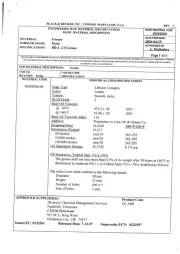
11 Februari 2025

29 Augustus 2024

15 Juli 2024

15 Juli 2024

25 Juni 2024

24 Juni 2024

24 Juni 2024

9 Juni 2024

9 Juni 2024
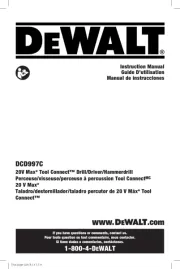
9 Juni 2024
Handleiding Hamer
- Full Boar
- Gude
- Scheppach
- Draper
- Power Craft
- Kraftixx
- Bavaria
- Trotec
- Bavaria By Einhell
- Anova
- Alpha Tools
- Kraftronic
- Powerfix
- Skil
- Parkside
Nieuwste handleidingen voor Hamer
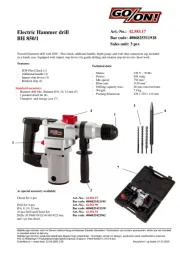
3 September 2025
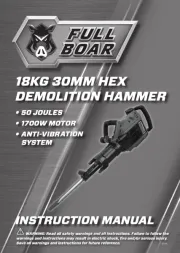
1 September 2025
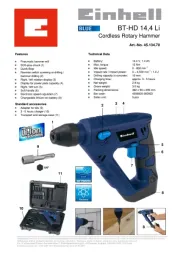
27 Augustus 2025
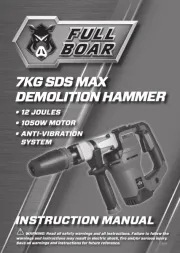
26 Augustus 2025
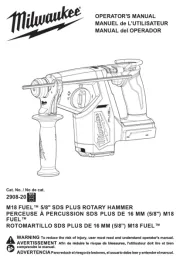
19 Augustus 2025
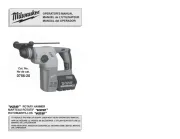
19 Augustus 2025
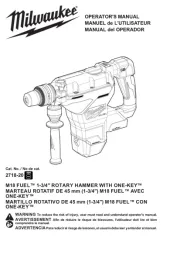
19 Augustus 2025
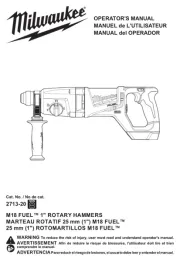
18 Augustus 2025
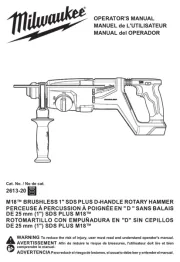
18 Augustus 2025
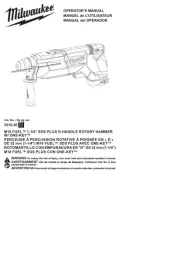
18 Augustus 2025